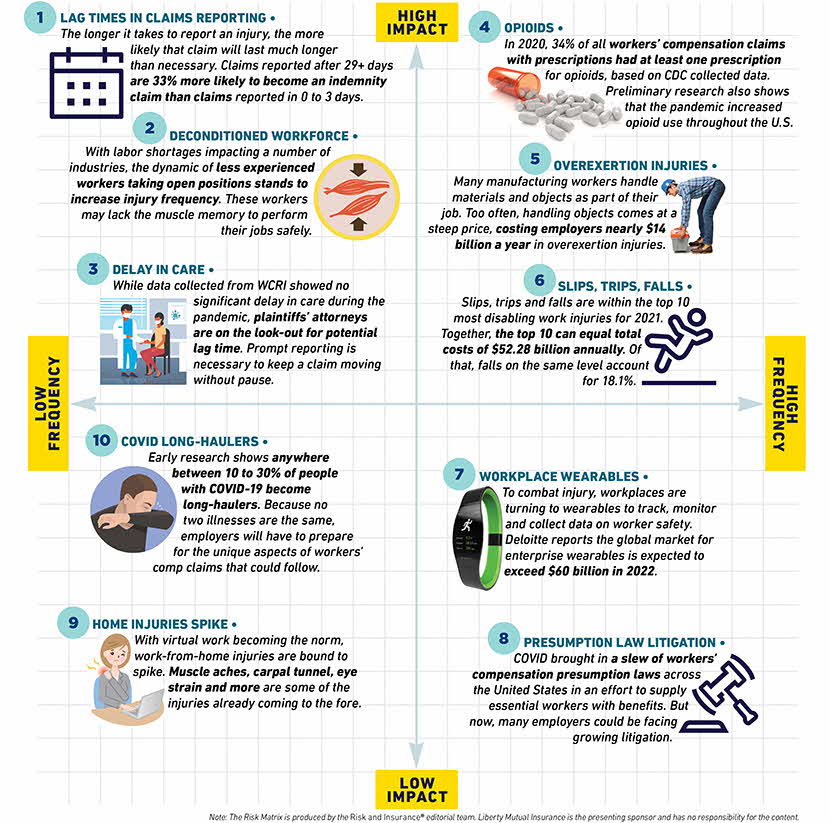
Introduction
From a deconditioned workforce and delayed claims reporting to COVID-19 long-haulers and overexertion injuries, here are key workers compensation risks to watch as businesses adapt in response to the pandemic.
The Risk Matrix, produced by the editorial team at Risk & Insurance®, plots critical risks shaping the workers compensation landscape based on the frequency and severity of each risk.
Lag times in claim reporting
Workplace injuries that go unreported can keep employees on the sidelines — uncertain about treatment and unclear on what to expect. In addition, the longer it takes to report an injury, the more likely that claim will last much longer than necessary. Claims reported after 29+ days are 33 percent more likely to become an indemnity claim and cost an average of 52 percent more than claims reported in 0 to 3 days. When workplace incidents do happen, prompt claim reporting is a key factor to ensuring injured employees receive the necessary care to feel supported in a successful return and minimizing business impact.
A deconditioned workforce
The pandemic-era trend toward layoffs and early retirement means today’s workforce has less training and experience than before the pandemic. Unfortunately, this deconditioned workforce poses new safety risks for companies, particularly in more risk-prone industries like manufacturing, trucking, and construction. While our workforce and working environment may be different from what it once was, a commitment to health, safety, and training should remain a key area of focus as companies begin returning to “business as usual.”
Delays in care
A delay in care can be just as damaging as a delay in claim reporting when it comes to positive workers compensation claims outcomes. While a recent study by the Workers Compensation Research Institute (WCRI) indicates that there has been no noticeable pandemic-related delay in medical treatment for injured workers for non-COVID-19 claims, ensuring that injured workers receive timely access to treatment is critical, especially as more employees return to work.
COVID-19 long-haulers
Early research shows anywhere between 10 to 30 percent of people with COVID-19 become long-haulers. Because no two illnesses are the same, employers will have to prepare for the unique aspects of workers compensation claims that could follow. With state-specific mandates rolling out that could impact the liability employers face for work-related COVID-19 infections, the medical reality of the COVID-19 long-hauler could complicate workers compensation claims.
Home injuries spike
With virtual work becoming the norm, work-from-home injuries are bound to spike. Muscle aches, carpal tunnel, eyestrain, and more are some of the injuries already coming to the forefront. Forward-thinking companies are issuing policies and taking measures to help ensure the safety of at-home workers. Determining whether an at-home workstation is ergonomically correct is one way that employers can help reduce the risk of injuries.
Opioids
In 2020, 34 percent of all workers compensation claims with prescriptions had at least one prescription for opioids, based on CDC-collected data. For injured workers who have been prescribed opioids as part of their treatments, social isolation and other pandemic-related stressors they experienced during the last 18 months could exacerbate the risk of opioid misuse and drive up the cost of workers compensation claims. When it comes to managing the impact of opioids, injured worker advocacy and building trust with injured workers can play a critical role.
Overexertion injuries
Handling materials and objects is part of the job for countless workers, from manufacturing and construction to wholesale. But these activities can come at a steep price, costing employers nearly $14 billion a year due to overexertion. Liberty Mutual’s award-winning ErgoValuator™ mobile app helps tackle this critical issue by helping employers pinpoint overexertion risk, protecting workers and ultimately stemming the flow of costly workers compensation claims.
Slips, trips, and falls
The top 10 causes of disabling workplace injuries cost businesses more than $52 billion a year – or $1 billion a week. Of the annual amount, injuries from slips, trips, and falls account for almost $20 billion. Industries such as hospitality and professional services, where falls are top drivers of loss, should put safety practices in place to keep hallways, stairways, and other walkways clean and free of water, debris, and other clutter to help mitigate the risk of these types of injuries.
Workplace wearables
The global market for enterprise wearables — including smart watches, smart glasses, hearables, and exoskeletons — is expected to grow 41 percent annually to exceed $60 billion in 2022, according to a report by Deloitte. And while wearable technology has much promise for helping drive greater health, safety, and productivity in the workplace, companies need to see the bigger picture before making the investment. Identifying the right technology solution to address a company’s specific safety issues and gaining employee buy-in are critical for successful implementation.
Presumption law litigation
In response to the pandemic, several states have passed legislation or used executive authority to extend workers compensation coverage to include COVID-19 as a work-related illness. Now, with many restrictions being lifted, many companies are hoping for a return to business as usual. But the transition out of lockdown doesn’t mean we can stop worrying about risk mitigation, especially when it comes to employee safety. Maintaining COVID-19 safety protocols, such as cleaning practices recommended by the Centers for Disease Control and Prevention and digital-first service models, can help mitigate exposure and related illnesses.
Featured insights
This website is general in nature, and is provided as a courtesy to you. Information is accurate to the best of Liberty Mutual’s knowledge, but companies and individuals should not rely on it to prevent and mitigate all risks as an explanation of coverage or benefits under an insurance policy. Consult your professional advisor regarding your particular facts and circumstance. By citing external authorities or linking to other websites, Liberty Mutual is not endorsing them.
The Risk Matrix is featured with the permission of Risk & Insurance®. The Risk Matrix is produced by the Risk & Insurance editorial team.



